On a Holland America Line cruise, explore Turkey, a country that for millennia has straddled East and West, Christianity and Islam, independence and invasion. Experience Istanbul’s magnificent Sophia Museum, Topkapi Palace and the Blue Mosque. Visit (Kusadasi) Ephesus, where one of the earliest Christian churches took root. Spend a day cruising the Dardanelles between the Sea of Marmara and the Aegean, one of the world’s most strategically important waterways. Relax on a sunny beach in Marmaris, once a safe haven for Alexander the Great.






